Endangered Species: Importance, Legal Concerns, and Causes of Extinction
VerifiedAdded on 2023/06/10
|13
|3986
|58
AI Summary
This article discusses the importance of endangered species, legal concerns, and causes of extinction. It highlights the impact of endangered species on human lives and the environment. The article also covers the United States’ Endangered Species Act and the need for a more integrated approach to conservation.
Contribute Materials
Your contribution can guide someone’s learning journey. Share your
documents today.
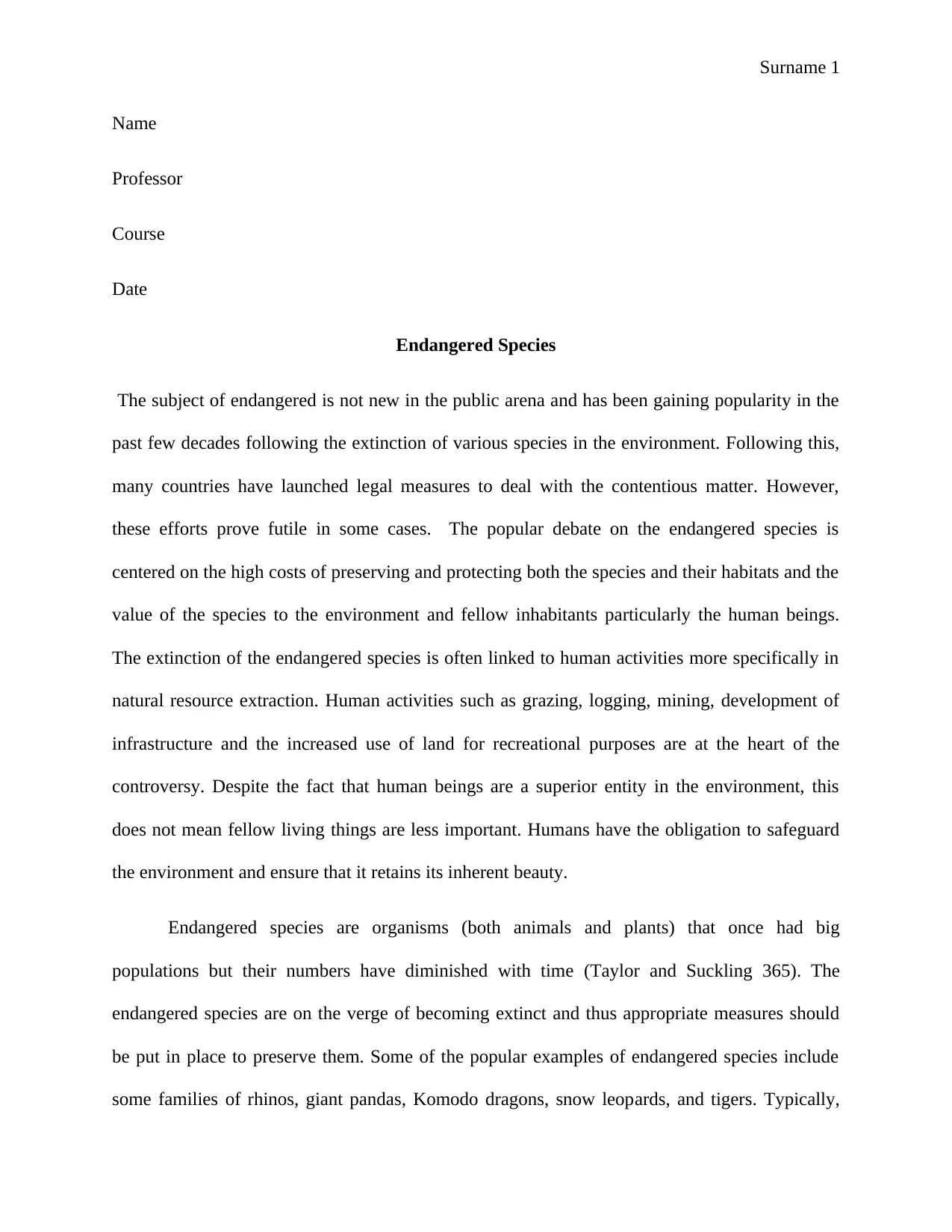
Surname 1
Name
Professor
Course
Date
Endangered Species
The subject of endangered is not new in the public arena and has been gaining popularity in the
past few decades following the extinction of various species in the environment. Following this,
many countries have launched legal measures to deal with the contentious matter. However,
these efforts prove futile in some cases. The popular debate on the endangered species is
centered on the high costs of preserving and protecting both the species and their habitats and the
value of the species to the environment and fellow inhabitants particularly the human beings.
The extinction of the endangered species is often linked to human activities more specifically in
natural resource extraction. Human activities such as grazing, logging, mining, development of
infrastructure and the increased use of land for recreational purposes are at the heart of the
controversy. Despite the fact that human beings are a superior entity in the environment, this
does not mean fellow living things are less important. Humans have the obligation to safeguard
the environment and ensure that it retains its inherent beauty.
Endangered species are organisms (both animals and plants) that once had big
populations but their numbers have diminished with time (Taylor and Suckling 365). The
endangered species are on the verge of becoming extinct and thus appropriate measures should
be put in place to preserve them. Some of the popular examples of endangered species include
some families of rhinos, giant pandas, Komodo dragons, snow leopards, and tigers. Typically,
Name
Professor
Course
Date
Endangered Species
The subject of endangered is not new in the public arena and has been gaining popularity in the
past few decades following the extinction of various species in the environment. Following this,
many countries have launched legal measures to deal with the contentious matter. However,
these efforts prove futile in some cases. The popular debate on the endangered species is
centered on the high costs of preserving and protecting both the species and their habitats and the
value of the species to the environment and fellow inhabitants particularly the human beings.
The extinction of the endangered species is often linked to human activities more specifically in
natural resource extraction. Human activities such as grazing, logging, mining, development of
infrastructure and the increased use of land for recreational purposes are at the heart of the
controversy. Despite the fact that human beings are a superior entity in the environment, this
does not mean fellow living things are less important. Humans have the obligation to safeguard
the environment and ensure that it retains its inherent beauty.
Endangered species are organisms (both animals and plants) that once had big
populations but their numbers have diminished with time (Taylor and Suckling 365). The
endangered species are on the verge of becoming extinct and thus appropriate measures should
be put in place to preserve them. Some of the popular examples of endangered species include
some families of rhinos, giant pandas, Komodo dragons, snow leopards, and tigers. Typically,
Secure Best Marks with AI Grader
Need help grading? Try our AI Grader for instant feedback on your assignments.
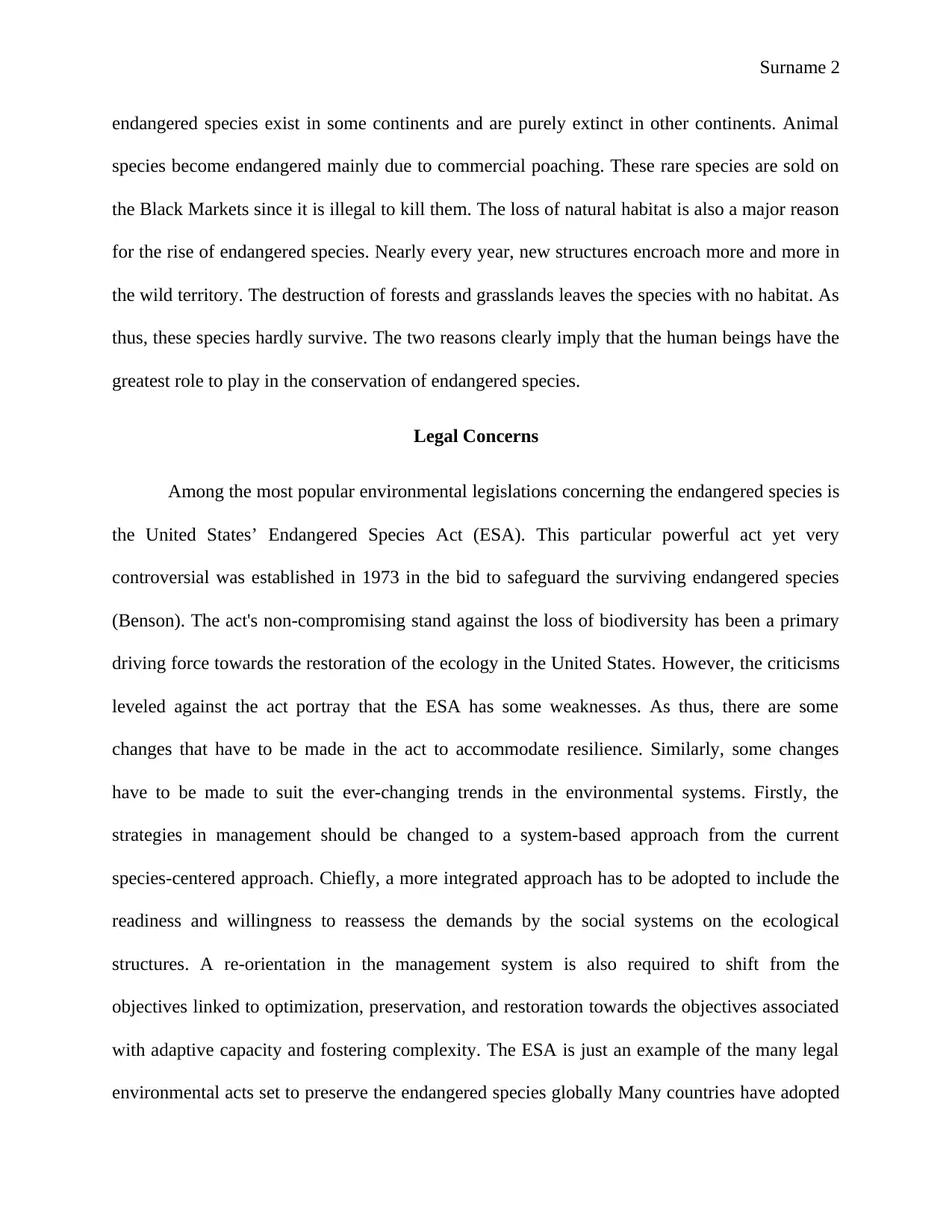
Surname 2
endangered species exist in some continents and are purely extinct in other continents. Animal
species become endangered mainly due to commercial poaching. These rare species are sold on
the Black Markets since it is illegal to kill them. The loss of natural habitat is also a major reason
for the rise of endangered species. Nearly every year, new structures encroach more and more in
the wild territory. The destruction of forests and grasslands leaves the species with no habitat. As
thus, these species hardly survive. The two reasons clearly imply that the human beings have the
greatest role to play in the conservation of endangered species.
Legal Concerns
Among the most popular environmental legislations concerning the endangered species is
the United States’ Endangered Species Act (ESA). This particular powerful act yet very
controversial was established in 1973 in the bid to safeguard the surviving endangered species
(Benson). The act's non-compromising stand against the loss of biodiversity has been a primary
driving force towards the restoration of the ecology in the United States. However, the criticisms
leveled against the act portray that the ESA has some weaknesses. As thus, there are some
changes that have to be made in the act to accommodate resilience. Similarly, some changes
have to be made to suit the ever-changing trends in the environmental systems. Firstly, the
strategies in management should be changed to a system-based approach from the current
species-centered approach. Chiefly, a more integrated approach has to be adopted to include the
readiness and willingness to reassess the demands by the social systems on the ecological
structures. A re-orientation in the management system is also required to shift from the
objectives linked to optimization, preservation, and restoration towards the objectives associated
with adaptive capacity and fostering complexity. The ESA is just an example of the many legal
environmental acts set to preserve the endangered species globally Many countries have adopted
endangered species exist in some continents and are purely extinct in other continents. Animal
species become endangered mainly due to commercial poaching. These rare species are sold on
the Black Markets since it is illegal to kill them. The loss of natural habitat is also a major reason
for the rise of endangered species. Nearly every year, new structures encroach more and more in
the wild territory. The destruction of forests and grasslands leaves the species with no habitat. As
thus, these species hardly survive. The two reasons clearly imply that the human beings have the
greatest role to play in the conservation of endangered species.
Legal Concerns
Among the most popular environmental legislations concerning the endangered species is
the United States’ Endangered Species Act (ESA). This particular powerful act yet very
controversial was established in 1973 in the bid to safeguard the surviving endangered species
(Benson). The act's non-compromising stand against the loss of biodiversity has been a primary
driving force towards the restoration of the ecology in the United States. However, the criticisms
leveled against the act portray that the ESA has some weaknesses. As thus, there are some
changes that have to be made in the act to accommodate resilience. Similarly, some changes
have to be made to suit the ever-changing trends in the environmental systems. Firstly, the
strategies in management should be changed to a system-based approach from the current
species-centered approach. Chiefly, a more integrated approach has to be adopted to include the
readiness and willingness to reassess the demands by the social systems on the ecological
structures. A re-orientation in the management system is also required to shift from the
objectives linked to optimization, preservation, and restoration towards the objectives associated
with adaptive capacity and fostering complexity. The ESA is just an example of the many legal
environmental acts set to preserve the endangered species globally Many countries have adopted

Surname 3
these laws with similar examples. The laws are not only at the state level but also at the local
levels. Different societies have devised varied means of preventing the possible extinction of
some species. Regardless of the country and level, all these legislations tend to assume a similar
course. Although they significantly contribute to the preservation of the endangered species, they
are hardly efficient and enough under the prevailing circumstances.
Ideally, most of the legalizations on the endangered species are coercive. This could be
blamed for poor planning and the perceived lack of awareness among the masses. Our
environments are the habitats that all the species should coexist peacefully. Certain groups
should not be given privileges over others. In order to ensure that these laws work effectively, all
eligible parties have to be consulted on the most appropriate measures. Human beings should not
be made to feel as if they are pushed to safeguard biodiversity yet it is their responsibility. On the
contrary, they should be made to be aware of why it is necessary to restore biodiversity.
Practically, people perform what they are convinced is right much better than what they are
coerced is right. As thus, preservation could only be upheld simply because an authority is on the
watch or to evade legal punishments.
Owing to the coercive nature of the environmental laws, the authorities tend to evict
people from their settlements feigning preservation. People should not be forced to vacate their
inhabitants without necessarily being compensated (Hing 226). The process of preserving the
endangered species should be interactive and systematic to ensure that no one becomes a victim
in the process of safeguarding biodiversity. The focus of the legalizations is far much too narrow
although the consultation process is very important. If people do so more voluntarily, there is the
preservation will be more successful.
these laws with similar examples. The laws are not only at the state level but also at the local
levels. Different societies have devised varied means of preventing the possible extinction of
some species. Regardless of the country and level, all these legislations tend to assume a similar
course. Although they significantly contribute to the preservation of the endangered species, they
are hardly efficient and enough under the prevailing circumstances.
Ideally, most of the legalizations on the endangered species are coercive. This could be
blamed for poor planning and the perceived lack of awareness among the masses. Our
environments are the habitats that all the species should coexist peacefully. Certain groups
should not be given privileges over others. In order to ensure that these laws work effectively, all
eligible parties have to be consulted on the most appropriate measures. Human beings should not
be made to feel as if they are pushed to safeguard biodiversity yet it is their responsibility. On the
contrary, they should be made to be aware of why it is necessary to restore biodiversity.
Practically, people perform what they are convinced is right much better than what they are
coerced is right. As thus, preservation could only be upheld simply because an authority is on the
watch or to evade legal punishments.
Owing to the coercive nature of the environmental laws, the authorities tend to evict
people from their settlements feigning preservation. People should not be forced to vacate their
inhabitants without necessarily being compensated (Hing 226). The process of preserving the
endangered species should be interactive and systematic to ensure that no one becomes a victim
in the process of safeguarding biodiversity. The focus of the legalizations is far much too narrow
although the consultation process is very important. If people do so more voluntarily, there is the
preservation will be more successful.
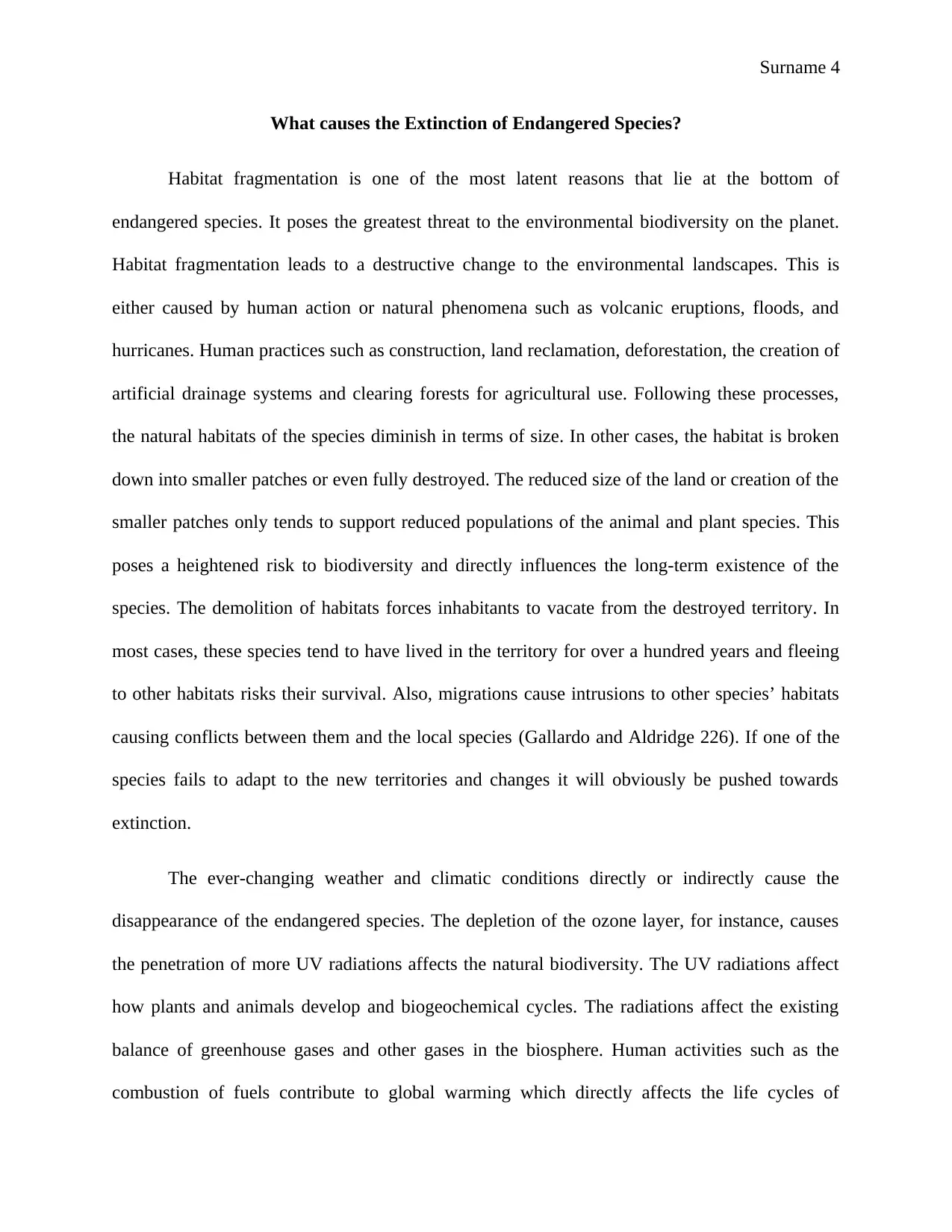
Surname 4
What causes the Extinction of Endangered Species?
Habitat fragmentation is one of the most latent reasons that lie at the bottom of
endangered species. It poses the greatest threat to the environmental biodiversity on the planet.
Habitat fragmentation leads to a destructive change to the environmental landscapes. This is
either caused by human action or natural phenomena such as volcanic eruptions, floods, and
hurricanes. Human practices such as construction, land reclamation, deforestation, the creation of
artificial drainage systems and clearing forests for agricultural use. Following these processes,
the natural habitats of the species diminish in terms of size. In other cases, the habitat is broken
down into smaller patches or even fully destroyed. The reduced size of the land or creation of the
smaller patches only tends to support reduced populations of the animal and plant species. This
poses a heightened risk to biodiversity and directly influences the long-term existence of the
species. The demolition of habitats forces inhabitants to vacate from the destroyed territory. In
most cases, these species tend to have lived in the territory for over a hundred years and fleeing
to other habitats risks their survival. Also, migrations cause intrusions to other species’ habitats
causing conflicts between them and the local species (Gallardo and Aldridge 226). If one of the
species fails to adapt to the new territories and changes it will obviously be pushed towards
extinction.
The ever-changing weather and climatic conditions directly or indirectly cause the
disappearance of the endangered species. The depletion of the ozone layer, for instance, causes
the penetration of more UV radiations affects the natural biodiversity. The UV radiations affect
how plants and animals develop and biogeochemical cycles. The radiations affect the existing
balance of greenhouse gases and other gases in the biosphere. Human activities such as the
combustion of fuels contribute to global warming which directly affects the life cycles of
What causes the Extinction of Endangered Species?
Habitat fragmentation is one of the most latent reasons that lie at the bottom of
endangered species. It poses the greatest threat to the environmental biodiversity on the planet.
Habitat fragmentation leads to a destructive change to the environmental landscapes. This is
either caused by human action or natural phenomena such as volcanic eruptions, floods, and
hurricanes. Human practices such as construction, land reclamation, deforestation, the creation of
artificial drainage systems and clearing forests for agricultural use. Following these processes,
the natural habitats of the species diminish in terms of size. In other cases, the habitat is broken
down into smaller patches or even fully destroyed. The reduced size of the land or creation of the
smaller patches only tends to support reduced populations of the animal and plant species. This
poses a heightened risk to biodiversity and directly influences the long-term existence of the
species. The demolition of habitats forces inhabitants to vacate from the destroyed territory. In
most cases, these species tend to have lived in the territory for over a hundred years and fleeing
to other habitats risks their survival. Also, migrations cause intrusions to other species’ habitats
causing conflicts between them and the local species (Gallardo and Aldridge 226). If one of the
species fails to adapt to the new territories and changes it will obviously be pushed towards
extinction.
The ever-changing weather and climatic conditions directly or indirectly cause the
disappearance of the endangered species. The depletion of the ozone layer, for instance, causes
the penetration of more UV radiations affects the natural biodiversity. The UV radiations affect
how plants and animals develop and biogeochemical cycles. The radiations affect the existing
balance of greenhouse gases and other gases in the biosphere. Human activities such as the
combustion of fuels contribute to global warming which directly affects the life cycles of
Secure Best Marks with AI Grader
Need help grading? Try our AI Grader for instant feedback on your assignments.

Surname 5
different species (Gallardo and Aldridge 223). The extinction of the endangered species occurs
along with the process of evolution. As the animals and plant species evolve, some of their
inherent adaptations fail. The failure to adopt the most essential characteristics to cope with the
environmental conditions makes it hard for them to survive. Although species usually change to
fit their respective habitats, this does not always happen especially in the cases where they have
been living in constant environments for quite some long.
In the prevailing circumstances, humans are usually pushed beyond their breaking points
to survive. The human population is rapidly increasing calling for alternative survival means.
They have to clear the vast forests to establish their settlements. These forests are the habitats of
many endangered species. Clearing the forests puts their survival at a risk. Similarly, the
endangered species are costly and those who poach them could earn a life from the illegal
practice. This is mostly prompted by the competitive economic environments with the
diminishing of the available natural resources.
The advancement in biotechnology could also be blamed for the foreseen disappearance of the
endangered species. The genetic modification species creates a competitive environment for the
naturally occurring species. The human beings are increasingly adopting the genetically modified
organisms at the expense of the natural ones. For instance, vast lands are cleared to plant
genetically modified foods which tend to mature much faster than the others. Also, the
genetically modified species are highly competitive compared to the natural once. Hence, when
left in a similar environment, the modified ones will automatically outdo the naturally existing
species.
The Importance of Protecting the Endangered Species
different species (Gallardo and Aldridge 223). The extinction of the endangered species occurs
along with the process of evolution. As the animals and plant species evolve, some of their
inherent adaptations fail. The failure to adopt the most essential characteristics to cope with the
environmental conditions makes it hard for them to survive. Although species usually change to
fit their respective habitats, this does not always happen especially in the cases where they have
been living in constant environments for quite some long.
In the prevailing circumstances, humans are usually pushed beyond their breaking points
to survive. The human population is rapidly increasing calling for alternative survival means.
They have to clear the vast forests to establish their settlements. These forests are the habitats of
many endangered species. Clearing the forests puts their survival at a risk. Similarly, the
endangered species are costly and those who poach them could earn a life from the illegal
practice. This is mostly prompted by the competitive economic environments with the
diminishing of the available natural resources.
The advancement in biotechnology could also be blamed for the foreseen disappearance of the
endangered species. The genetic modification species creates a competitive environment for the
naturally occurring species. The human beings are increasingly adopting the genetically modified
organisms at the expense of the natural ones. For instance, vast lands are cleared to plant
genetically modified foods which tend to mature much faster than the others. Also, the
genetically modified species are highly competitive compared to the natural once. Hence, when
left in a similar environment, the modified ones will automatically outdo the naturally existing
species.
The Importance of Protecting the Endangered Species
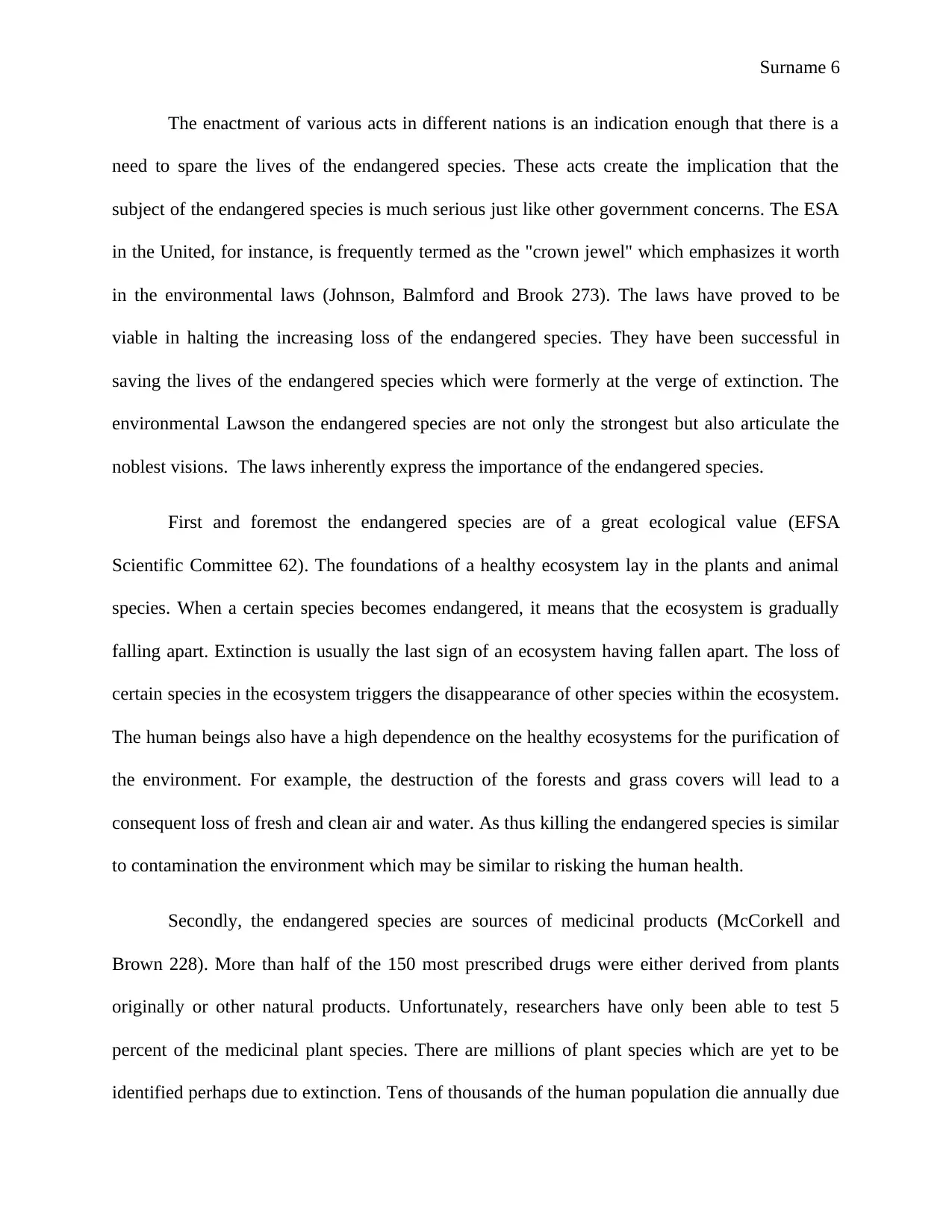
Surname 6
The enactment of various acts in different nations is an indication enough that there is a
need to spare the lives of the endangered species. These acts create the implication that the
subject of the endangered species is much serious just like other government concerns. The ESA
in the United, for instance, is frequently termed as the "crown jewel" which emphasizes it worth
in the environmental laws (Johnson, Balmford and Brook 273). The laws have proved to be
viable in halting the increasing loss of the endangered species. They have been successful in
saving the lives of the endangered species which were formerly at the verge of extinction. The
environmental Lawson the endangered species are not only the strongest but also articulate the
noblest visions. The laws inherently express the importance of the endangered species.
First and foremost the endangered species are of a great ecological value (EFSA
Scientific Committee 62). The foundations of a healthy ecosystem lay in the plants and animal
species. When a certain species becomes endangered, it means that the ecosystem is gradually
falling apart. Extinction is usually the last sign of an ecosystem having fallen apart. The loss of
certain species in the ecosystem triggers the disappearance of other species within the ecosystem.
The human beings also have a high dependence on the healthy ecosystems for the purification of
the environment. For example, the destruction of the forests and grass covers will lead to a
consequent loss of fresh and clean air and water. As thus killing the endangered species is similar
to contamination the environment which may be similar to risking the human health.
Secondly, the endangered species are sources of medicinal products (McCorkell and
Brown 228). More than half of the 150 most prescribed drugs were either derived from plants
originally or other natural products. Unfortunately, researchers have only been able to test 5
percent of the medicinal plant species. There are millions of plant species which are yet to be
identified perhaps due to extinction. Tens of thousands of the human population die annually due
The enactment of various acts in different nations is an indication enough that there is a
need to spare the lives of the endangered species. These acts create the implication that the
subject of the endangered species is much serious just like other government concerns. The ESA
in the United, for instance, is frequently termed as the "crown jewel" which emphasizes it worth
in the environmental laws (Johnson, Balmford and Brook 273). The laws have proved to be
viable in halting the increasing loss of the endangered species. They have been successful in
saving the lives of the endangered species which were formerly at the verge of extinction. The
environmental Lawson the endangered species are not only the strongest but also articulate the
noblest visions. The laws inherently express the importance of the endangered species.
First and foremost the endangered species are of a great ecological value (EFSA
Scientific Committee 62). The foundations of a healthy ecosystem lay in the plants and animal
species. When a certain species becomes endangered, it means that the ecosystem is gradually
falling apart. Extinction is usually the last sign of an ecosystem having fallen apart. The loss of
certain species in the ecosystem triggers the disappearance of other species within the ecosystem.
The human beings also have a high dependence on the healthy ecosystems for the purification of
the environment. For example, the destruction of the forests and grass covers will lead to a
consequent loss of fresh and clean air and water. As thus killing the endangered species is similar
to contamination the environment which may be similar to risking the human health.
Secondly, the endangered species are sources of medicinal products (McCorkell and
Brown 228). More than half of the 150 most prescribed drugs were either derived from plants
originally or other natural products. Unfortunately, researchers have only been able to test 5
percent of the medicinal plant species. There are millions of plant species which are yet to be
identified perhaps due to extinction. Tens of thousands of the human population die annually due
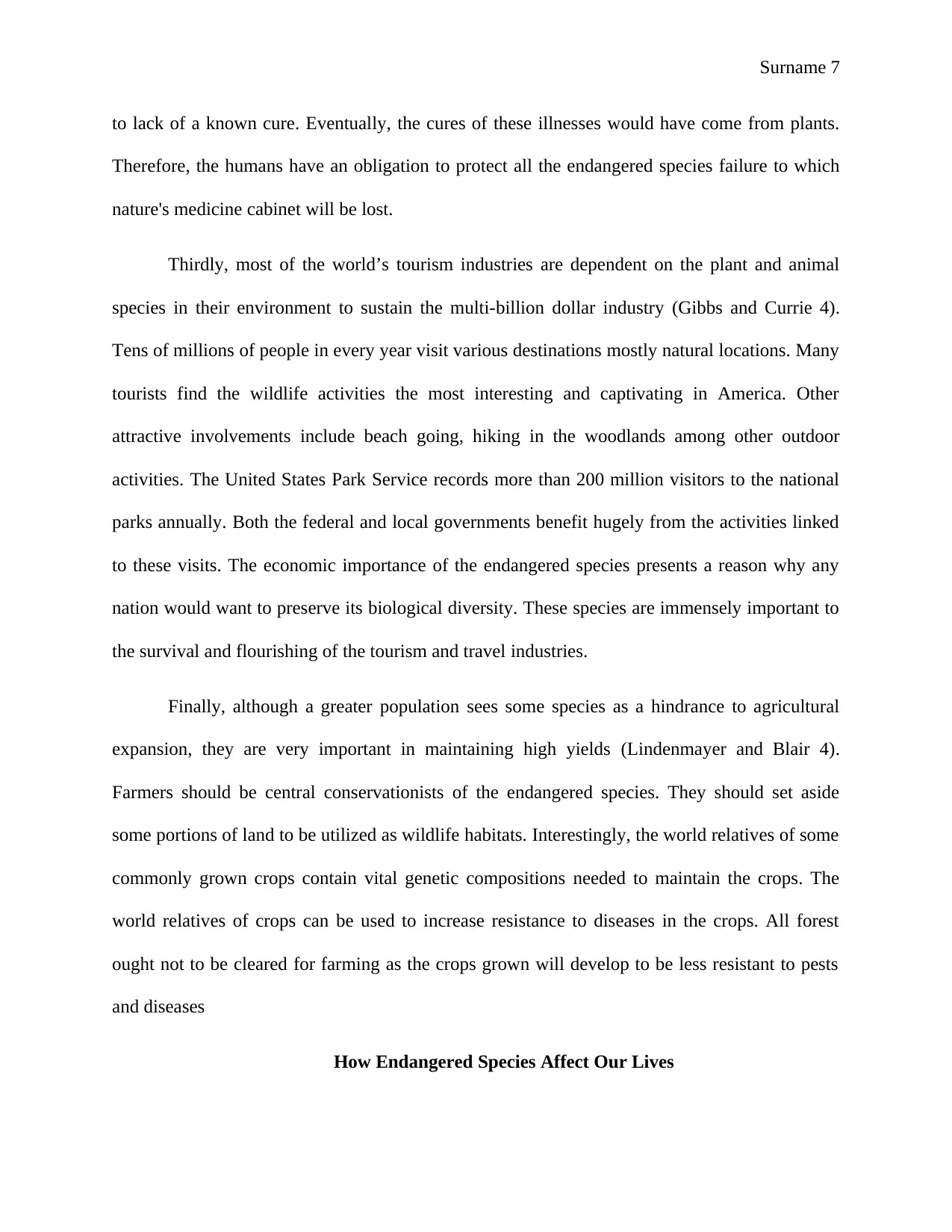
Surname 7
to lack of a known cure. Eventually, the cures of these illnesses would have come from plants.
Therefore, the humans have an obligation to protect all the endangered species failure to which
nature's medicine cabinet will be lost.
Thirdly, most of the world’s tourism industries are dependent on the plant and animal
species in their environment to sustain the multi-billion dollar industry (Gibbs and Currie 4).
Tens of millions of people in every year visit various destinations mostly natural locations. Many
tourists find the wildlife activities the most interesting and captivating in America. Other
attractive involvements include beach going, hiking in the woodlands among other outdoor
activities. The United States Park Service records more than 200 million visitors to the national
parks annually. Both the federal and local governments benefit hugely from the activities linked
to these visits. The economic importance of the endangered species presents a reason why any
nation would want to preserve its biological diversity. These species are immensely important to
the survival and flourishing of the tourism and travel industries.
Finally, although a greater population sees some species as a hindrance to agricultural
expansion, they are very important in maintaining high yields (Lindenmayer and Blair 4).
Farmers should be central conservationists of the endangered species. They should set aside
some portions of land to be utilized as wildlife habitats. Interestingly, the world relatives of some
commonly grown crops contain vital genetic compositions needed to maintain the crops. The
world relatives of crops can be used to increase resistance to diseases in the crops. All forest
ought not to be cleared for farming as the crops grown will develop to be less resistant to pests
and diseases
How Endangered Species Affect Our Lives
to lack of a known cure. Eventually, the cures of these illnesses would have come from plants.
Therefore, the humans have an obligation to protect all the endangered species failure to which
nature's medicine cabinet will be lost.
Thirdly, most of the world’s tourism industries are dependent on the plant and animal
species in their environment to sustain the multi-billion dollar industry (Gibbs and Currie 4).
Tens of millions of people in every year visit various destinations mostly natural locations. Many
tourists find the wildlife activities the most interesting and captivating in America. Other
attractive involvements include beach going, hiking in the woodlands among other outdoor
activities. The United States Park Service records more than 200 million visitors to the national
parks annually. Both the federal and local governments benefit hugely from the activities linked
to these visits. The economic importance of the endangered species presents a reason why any
nation would want to preserve its biological diversity. These species are immensely important to
the survival and flourishing of the tourism and travel industries.
Finally, although a greater population sees some species as a hindrance to agricultural
expansion, they are very important in maintaining high yields (Lindenmayer and Blair 4).
Farmers should be central conservationists of the endangered species. They should set aside
some portions of land to be utilized as wildlife habitats. Interestingly, the world relatives of some
commonly grown crops contain vital genetic compositions needed to maintain the crops. The
world relatives of crops can be used to increase resistance to diseases in the crops. All forest
ought not to be cleared for farming as the crops grown will develop to be less resistant to pests
and diseases
How Endangered Species Affect Our Lives
Paraphrase This Document
Need a fresh take? Get an instant paraphrase of this document with our AI Paraphraser
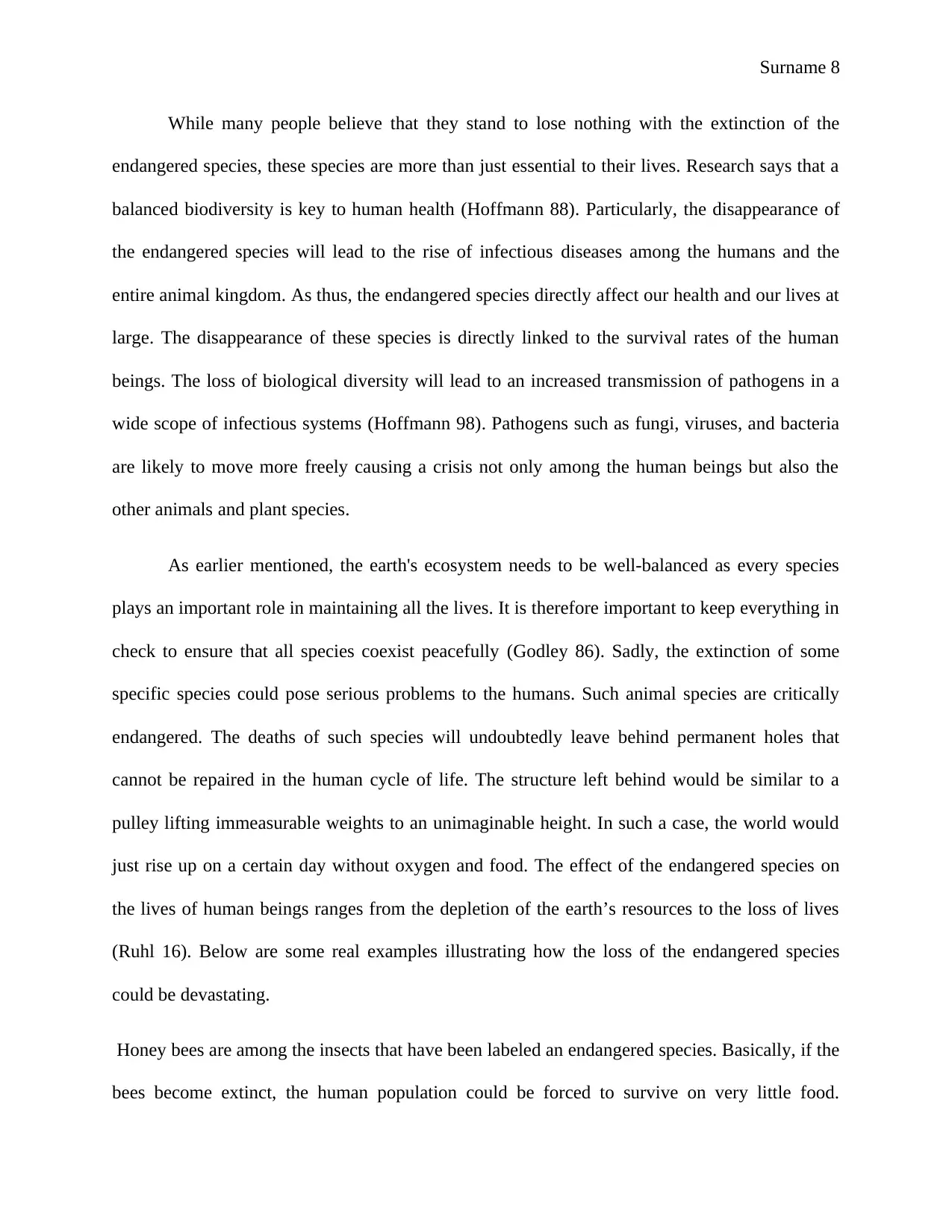
Surname 8
While many people believe that they stand to lose nothing with the extinction of the
endangered species, these species are more than just essential to their lives. Research says that a
balanced biodiversity is key to human health (Hoffmann 88). Particularly, the disappearance of
the endangered species will lead to the rise of infectious diseases among the humans and the
entire animal kingdom. As thus, the endangered species directly affect our health and our lives at
large. The disappearance of these species is directly linked to the survival rates of the human
beings. The loss of biological diversity will lead to an increased transmission of pathogens in a
wide scope of infectious systems (Hoffmann 98). Pathogens such as fungi, viruses, and bacteria
are likely to move more freely causing a crisis not only among the human beings but also the
other animals and plant species.
As earlier mentioned, the earth's ecosystem needs to be well-balanced as every species
plays an important role in maintaining all the lives. It is therefore important to keep everything in
check to ensure that all species coexist peacefully (Godley 86). Sadly, the extinction of some
specific species could pose serious problems to the humans. Such animal species are critically
endangered. The deaths of such species will undoubtedly leave behind permanent holes that
cannot be repaired in the human cycle of life. The structure left behind would be similar to a
pulley lifting immeasurable weights to an unimaginable height. In such a case, the world would
just rise up on a certain day without oxygen and food. The effect of the endangered species on
the lives of human beings ranges from the depletion of the earth’s resources to the loss of lives
(Ruhl 16). Below are some real examples illustrating how the loss of the endangered species
could be devastating.
Honey bees are among the insects that have been labeled an endangered species. Basically, if the
bees become extinct, the human population could be forced to survive on very little food.
While many people believe that they stand to lose nothing with the extinction of the
endangered species, these species are more than just essential to their lives. Research says that a
balanced biodiversity is key to human health (Hoffmann 88). Particularly, the disappearance of
the endangered species will lead to the rise of infectious diseases among the humans and the
entire animal kingdom. As thus, the endangered species directly affect our health and our lives at
large. The disappearance of these species is directly linked to the survival rates of the human
beings. The loss of biological diversity will lead to an increased transmission of pathogens in a
wide scope of infectious systems (Hoffmann 98). Pathogens such as fungi, viruses, and bacteria
are likely to move more freely causing a crisis not only among the human beings but also the
other animals and plant species.
As earlier mentioned, the earth's ecosystem needs to be well-balanced as every species
plays an important role in maintaining all the lives. It is therefore important to keep everything in
check to ensure that all species coexist peacefully (Godley 86). Sadly, the extinction of some
specific species could pose serious problems to the humans. Such animal species are critically
endangered. The deaths of such species will undoubtedly leave behind permanent holes that
cannot be repaired in the human cycle of life. The structure left behind would be similar to a
pulley lifting immeasurable weights to an unimaginable height. In such a case, the world would
just rise up on a certain day without oxygen and food. The effect of the endangered species on
the lives of human beings ranges from the depletion of the earth’s resources to the loss of lives
(Ruhl 16). Below are some real examples illustrating how the loss of the endangered species
could be devastating.
Honey bees are among the insects that have been labeled an endangered species. Basically, if the
bees become extinct, the human population could be forced to survive on very little food.

Surname 9
Practically, there is much that has been done to preserve the dwindling bee population. The
preservation of the honey bee species is worth the effort. Honey bees help in the sustenance of
the food chain by pollinating the flowers (Echeverri, Callahan and Satterfield 13). As thus the
bees breathe life into the ecosystem. Approximately, around seven species of the honey bees
stand a risk of extinction. The honey bees have been an essential aspect of the food chain since
time in history.
The extinction of some endangered species will rob the humans the ability to make
further medical advancements (US Geological Survey 3). Different endangered species possess
unique body processes that provide insights in the bid to cure human diseases. For example, the
dart poison frogs found in the rainforests offer a priceless information about the behavior of
alkaloid compounds in living organisms. Bears are also studied by scientists to provide
invaluable insights about kidney disorders and their treatment. Each endangered species that
punishes dictates the number of viable medical breakthroughs. The extinction of the endangered
species poses a great blow to the human population.
Measures to Preserve and Protect the Endangered Species
A significant number of the entire human population have been blinded and hardly see
the interconnectedness of the endangered species with life. We at times fail to understand how
the ecosystem is made up of interdependent species. Humans ought to understand that they
preserve the endangered species for their own good and not for the species’ good. The ordinary
citizens have the greatest role to play in the preservation of the endangered species. The little
things that we do really matter. There are many ways in which an ordinary citizen can save the
ecosystem from falling apart. This does not mean that the greater organizations have no role to
play. They should focus on greater policies to supplement the efforts of the ordinary citizens.
Practically, there is much that has been done to preserve the dwindling bee population. The
preservation of the honey bee species is worth the effort. Honey bees help in the sustenance of
the food chain by pollinating the flowers (Echeverri, Callahan and Satterfield 13). As thus the
bees breathe life into the ecosystem. Approximately, around seven species of the honey bees
stand a risk of extinction. The honey bees have been an essential aspect of the food chain since
time in history.
The extinction of some endangered species will rob the humans the ability to make
further medical advancements (US Geological Survey 3). Different endangered species possess
unique body processes that provide insights in the bid to cure human diseases. For example, the
dart poison frogs found in the rainforests offer a priceless information about the behavior of
alkaloid compounds in living organisms. Bears are also studied by scientists to provide
invaluable insights about kidney disorders and their treatment. Each endangered species that
punishes dictates the number of viable medical breakthroughs. The extinction of the endangered
species poses a great blow to the human population.
Measures to Preserve and Protect the Endangered Species
A significant number of the entire human population have been blinded and hardly see
the interconnectedness of the endangered species with life. We at times fail to understand how
the ecosystem is made up of interdependent species. Humans ought to understand that they
preserve the endangered species for their own good and not for the species’ good. The ordinary
citizens have the greatest role to play in the preservation of the endangered species. The little
things that we do really matter. There are many ways in which an ordinary citizen can save the
ecosystem from falling apart. This does not mean that the greater organizations have no role to
play. They should focus on greater policies to supplement the efforts of the ordinary citizens.
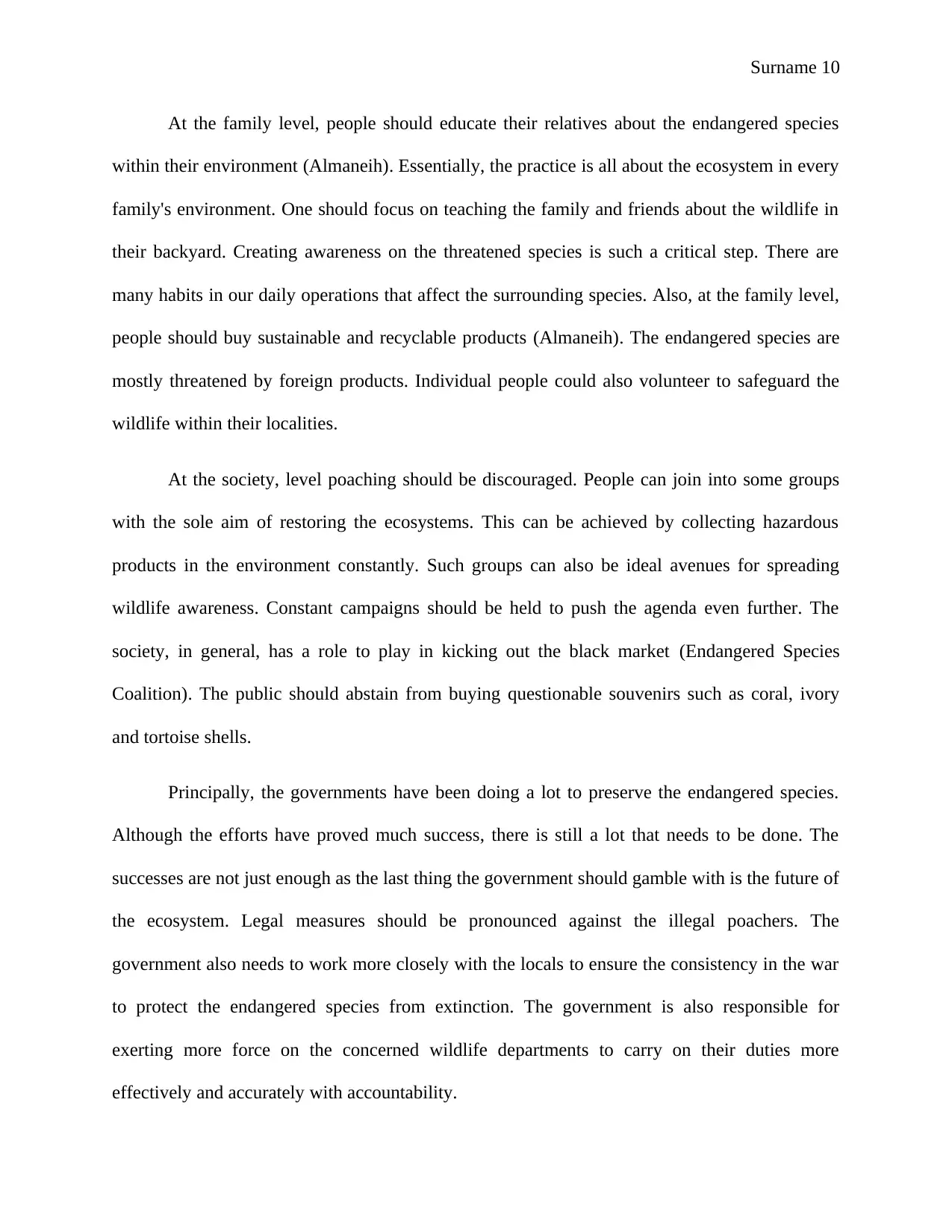
Surname 10
At the family level, people should educate their relatives about the endangered species
within their environment (Almaneih). Essentially, the practice is all about the ecosystem in every
family's environment. One should focus on teaching the family and friends about the wildlife in
their backyard. Creating awareness on the threatened species is such a critical step. There are
many habits in our daily operations that affect the surrounding species. Also, at the family level,
people should buy sustainable and recyclable products (Almaneih). The endangered species are
mostly threatened by foreign products. Individual people could also volunteer to safeguard the
wildlife within their localities.
At the society, level poaching should be discouraged. People can join into some groups
with the sole aim of restoring the ecosystems. This can be achieved by collecting hazardous
products in the environment constantly. Such groups can also be ideal avenues for spreading
wildlife awareness. Constant campaigns should be held to push the agenda even further. The
society, in general, has a role to play in kicking out the black market (Endangered Species
Coalition). The public should abstain from buying questionable souvenirs such as coral, ivory
and tortoise shells.
Principally, the governments have been doing a lot to preserve the endangered species.
Although the efforts have proved much success, there is still a lot that needs to be done. The
successes are not just enough as the last thing the government should gamble with is the future of
the ecosystem. Legal measures should be pronounced against the illegal poachers. The
government also needs to work more closely with the locals to ensure the consistency in the war
to protect the endangered species from extinction. The government is also responsible for
exerting more force on the concerned wildlife departments to carry on their duties more
effectively and accurately with accountability.
At the family level, people should educate their relatives about the endangered species
within their environment (Almaneih). Essentially, the practice is all about the ecosystem in every
family's environment. One should focus on teaching the family and friends about the wildlife in
their backyard. Creating awareness on the threatened species is such a critical step. There are
many habits in our daily operations that affect the surrounding species. Also, at the family level,
people should buy sustainable and recyclable products (Almaneih). The endangered species are
mostly threatened by foreign products. Individual people could also volunteer to safeguard the
wildlife within their localities.
At the society, level poaching should be discouraged. People can join into some groups
with the sole aim of restoring the ecosystems. This can be achieved by collecting hazardous
products in the environment constantly. Such groups can also be ideal avenues for spreading
wildlife awareness. Constant campaigns should be held to push the agenda even further. The
society, in general, has a role to play in kicking out the black market (Endangered Species
Coalition). The public should abstain from buying questionable souvenirs such as coral, ivory
and tortoise shells.
Principally, the governments have been doing a lot to preserve the endangered species.
Although the efforts have proved much success, there is still a lot that needs to be done. The
successes are not just enough as the last thing the government should gamble with is the future of
the ecosystem. Legal measures should be pronounced against the illegal poachers. The
government also needs to work more closely with the locals to ensure the consistency in the war
to protect the endangered species from extinction. The government is also responsible for
exerting more force on the concerned wildlife departments to carry on their duties more
effectively and accurately with accountability.
Secure Best Marks with AI Grader
Need help grading? Try our AI Grader for instant feedback on your assignments.
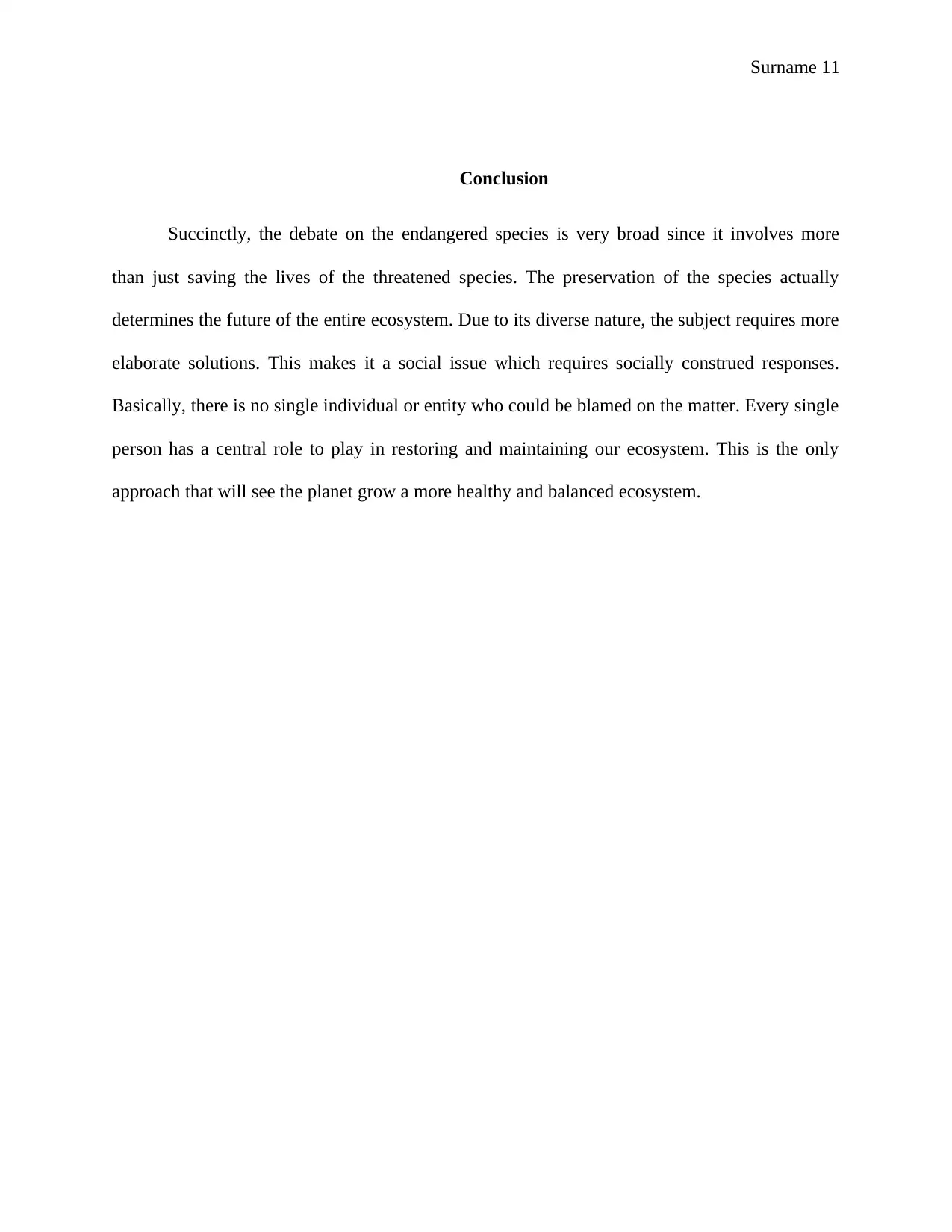
Surname 11
Conclusion
Succinctly, the debate on the endangered species is very broad since it involves more
than just saving the lives of the threatened species. The preservation of the species actually
determines the future of the entire ecosystem. Due to its diverse nature, the subject requires more
elaborate solutions. This makes it a social issue which requires socially construed responses.
Basically, there is no single individual or entity who could be blamed on the matter. Every single
person has a central role to play in restoring and maintaining our ecosystem. This is the only
approach that will see the planet grow a more healthy and balanced ecosystem.
Conclusion
Succinctly, the debate on the endangered species is very broad since it involves more
than just saving the lives of the threatened species. The preservation of the species actually
determines the future of the entire ecosystem. Due to its diverse nature, the subject requires more
elaborate solutions. This makes it a social issue which requires socially construed responses.
Basically, there is no single individual or entity who could be blamed on the matter. Every single
person has a central role to play in restoring and maintaining our ecosystem. This is the only
approach that will see the planet grow a more healthy and balanced ecosystem.

Surname 12
Works Cited
Almaneih, Susie. 12 Things We Should All Do To Protect Endangered Species. March 14, 2017.
8 August 2018. <https://www.huffingtonpost.com/entry/12-things-we-should-all-do-to-
protect-endangered-species_us_58bd9c87e4b0abcb02ce2067>.
Benson, M. H. "Intelligent Tinkering: the Endangered Species Act and Resilience. Ecology and
Society." 2012.
Echeverri, Alejandra, Megan M Callahan and Terre Satterfield. "Explicit Not Implicit
Preferences Predict Conservation Intentions for Endangered Species and Biomes." PLOS
ONE 12.1 (2017): 1-18.
EFSA Scientific Committee. "Coverage of endangered species in environmental risk assessments
at EFSA." EFSA Journal 14.2 (2016): 22-87.
Endangered Species Coalition. 10 Easy Things You Can Do to Save Endangered Species. n.d. 8
August 2018. <http://www.endangered.org/10-easy-things-you-can-do-to-save-
endangered-species/>.
Gallardo, Belinda and David C Aldridge. "Evaluating the combined threat of climate change and
biological invasions on endangered species." Biological Conservation 160 (2013): 225–
233.
Gibbs, Katherine E., and David J Currie. "Protecting Endangered Species: Do the Main
Legislative Tools Work?" PLoS ONE 7.5 (2012): 1-7.
Godley, Brendan J. "Incorporating climate change into endangered species conservation:
Introduction." Endangered Species Research 7 (2013): 85-86.
Hing, Stephanie. "First parasitological survey of Endangered Bornean elephants Elephas
maximus borneensis." Journal of Endangered Species Research 21 (2013): 223–230.
Hoffmann, John P. "Social and Environmental Influences on Endangered Species: A Cross-
National Study." Sociological Perspectives 47.1 (2014): 79-107.
Works Cited
Almaneih, Susie. 12 Things We Should All Do To Protect Endangered Species. March 14, 2017.
8 August 2018. <https://www.huffingtonpost.com/entry/12-things-we-should-all-do-to-
protect-endangered-species_us_58bd9c87e4b0abcb02ce2067>.
Benson, M. H. "Intelligent Tinkering: the Endangered Species Act and Resilience. Ecology and
Society." 2012.
Echeverri, Alejandra, Megan M Callahan and Terre Satterfield. "Explicit Not Implicit
Preferences Predict Conservation Intentions for Endangered Species and Biomes." PLOS
ONE 12.1 (2017): 1-18.
EFSA Scientific Committee. "Coverage of endangered species in environmental risk assessments
at EFSA." EFSA Journal 14.2 (2016): 22-87.
Endangered Species Coalition. 10 Easy Things You Can Do to Save Endangered Species. n.d. 8
August 2018. <http://www.endangered.org/10-easy-things-you-can-do-to-save-
endangered-species/>.
Gallardo, Belinda and David C Aldridge. "Evaluating the combined threat of climate change and
biological invasions on endangered species." Biological Conservation 160 (2013): 225–
233.
Gibbs, Katherine E., and David J Currie. "Protecting Endangered Species: Do the Main
Legislative Tools Work?" PLoS ONE 7.5 (2012): 1-7.
Godley, Brendan J. "Incorporating climate change into endangered species conservation:
Introduction." Endangered Species Research 7 (2013): 85-86.
Hing, Stephanie. "First parasitological survey of Endangered Bornean elephants Elephas
maximus borneensis." Journal of Endangered Species Research 21 (2013): 223–230.
Hoffmann, John P. "Social and Environmental Influences on Endangered Species: A Cross-
National Study." Sociological Perspectives 47.1 (2014): 79-107.
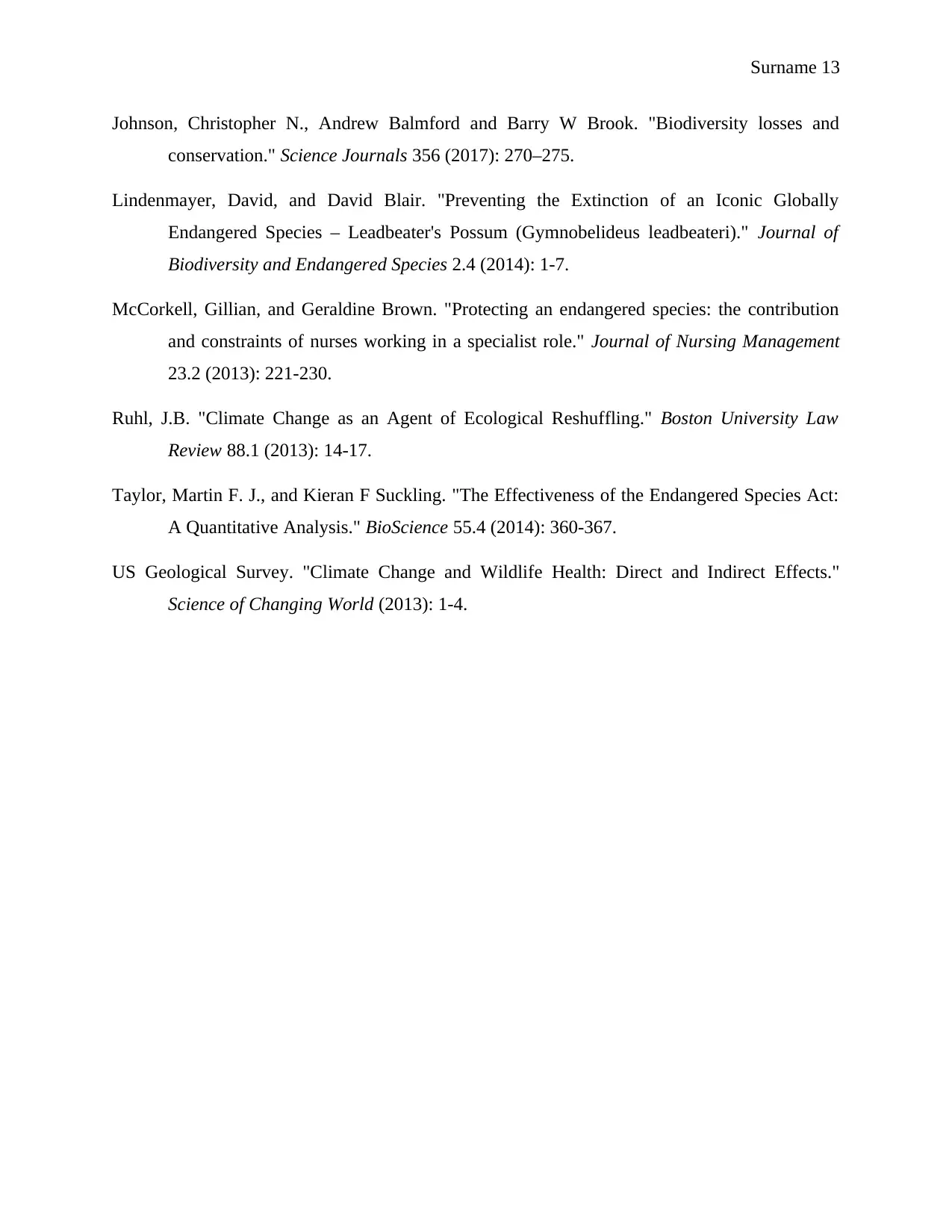
Surname 13
Johnson, Christopher N., Andrew Balmford and Barry W Brook. "Biodiversity losses and
conservation." Science Journals 356 (2017): 270–275.
Lindenmayer, David, and David Blair. "Preventing the Extinction of an Iconic Globally
Endangered Species – Leadbeater's Possum (Gymnobelideus leadbeateri)." Journal of
Biodiversity and Endangered Species 2.4 (2014): 1-7.
McCorkell, Gillian, and Geraldine Brown. "Protecting an endangered species: the contribution
and constraints of nurses working in a specialist role." Journal of Nursing Management
23.2 (2013): 221-230.
Ruhl, J.B. "Climate Change as an Agent of Ecological Reshuffling." Boston University Law
Review 88.1 (2013): 14-17.
Taylor, Martin F. J., and Kieran F Suckling. "The Effectiveness of the Endangered Species Act:
A Quantitative Analysis." BioScience 55.4 (2014): 360-367.
US Geological Survey. "Climate Change and Wildlife Health: Direct and Indirect Effects."
Science of Changing World (2013): 1-4.
Johnson, Christopher N., Andrew Balmford and Barry W Brook. "Biodiversity losses and
conservation." Science Journals 356 (2017): 270–275.
Lindenmayer, David, and David Blair. "Preventing the Extinction of an Iconic Globally
Endangered Species – Leadbeater's Possum (Gymnobelideus leadbeateri)." Journal of
Biodiversity and Endangered Species 2.4 (2014): 1-7.
McCorkell, Gillian, and Geraldine Brown. "Protecting an endangered species: the contribution
and constraints of nurses working in a specialist role." Journal of Nursing Management
23.2 (2013): 221-230.
Ruhl, J.B. "Climate Change as an Agent of Ecological Reshuffling." Boston University Law
Review 88.1 (2013): 14-17.
Taylor, Martin F. J., and Kieran F Suckling. "The Effectiveness of the Endangered Species Act:
A Quantitative Analysis." BioScience 55.4 (2014): 360-367.
US Geological Survey. "Climate Change and Wildlife Health: Direct and Indirect Effects."
Science of Changing World (2013): 1-4.
1 out of 13
Related Documents
Your All-in-One AI-Powered Toolkit for Academic Success.
+13062052269
info@desklib.com
Available 24*7 on WhatsApp / Email
![[object Object]](/_next/static/media/star-bottom.7253800d.svg)
Unlock your academic potential
© 2024 | Zucol Services PVT LTD | All rights reserved.





